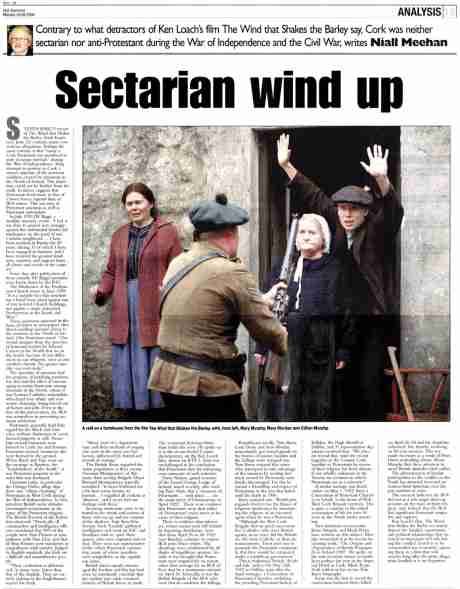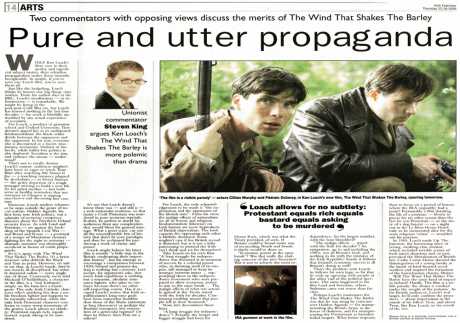Sectarian Wind Up - a defence of The Wind that Shakes the Barley
 national |
history and heritage |
other press
national |
history and heritage |
other press  Friday June 30, 2006 10:33
Friday June 30, 2006 10:33 by Niall Meehan - Irish Examiner June 26th 2006
by Niall Meehan - Irish Examiner June 26th 2006
And a defence of the anti-sectarian nature of the Irish War of Independence
"Practically all commanders and intelligence officers considered that 90 per cent of the people were Sinn Féiners or sympathisers with Sinn Féin, and that all Sinn Féiners were murderers or sympathisers with murder. Judged by English standards, the Irish are a difficult and unsatisfactory people. Their civilisation is different and in many ways lower than that of the English. They are entirely lacking in the Englishman's respect for truth . . . Many were of a degenerate type and their methods of waging war were in the most case barbarous, influenced by hatred and devoid of courage."
British intelligence assessment of the Irish People from The Record of the Rebellion
Steven King's review of 'The Wind that Shakes the Barley' contains many contentious allegations. Perhaps the most extreme is that "many a Cork Protestant was murdered in pure sectarian reprisals" during the War of Independence. King attempts to portray in Cork a mirror opposite of the sectarian cauldron created by Unionism in the North of Ireland. This depiction could not be further from the truth. Evidence suggests that Protestants lived more in fear of Crown Forces reprisal than of IRA action. This was true of Protestant unionists as well as Protestant nationalists.
In July 1920 Mr J.W. Biggs, a wealthy Unionist, wrote:
"I feel it my duty to protest very strongly against this unfounded slander (of intolerance on the part) of our Catholic neighbours ... I have been resident in Bantry for 43 years, during 33 of which I have been engaged in business, and I have received the greatest kindness, courtesy, and support from all classes and creeds in the country".
Some days after publication of these remarks Mr Biggs' business premises, valued at £20,000, were burnt down by the RIC.
The Moderator of the Presbyterian Church wrote in June 1920:
"it is a notable fact that nowhere has a hand been raised against one of our isolated Church buildings, nor against a single individual Presbyterian in the South and West".
These assertions appeared in the form of letters to newspapers after blood curdling unionist claims to the contrary in the North of Ireland. One Protestant stated:
"One would imagine from the speeches of [Unionist leader] Sir Edward Carson in the North that we in the South, because of our differences in our religions, were at one another's throats. No greater mistake was ever made".
The speeches of unionists had the purpose of justifying partition, but also had the effect of encouraging sectarian fanaticism among unionists in the North, where it was nationalists who suffered real ethnic and economic 'cleansing', being forced out of homes and jobs. Even in the face of this provocation the IRA was scrupulous in preventing sectarian retaliation.
Protestants generally held little regard for the Black and Tans who, without distinction of creed, burned property at will. Protestant owned businesses were burned in Cork City and Fermoy. Protestant owned creameries also were burned to the ground. When Black and Tans and the military went on the rampage in Bandon, the 'Londondery of the South', it was Protestant property in the main that was destroyed.
Unionists today, in particular the Orange Order, allege that there was "ethnic cleansing" of Protestants in West Cork during the War of Independence. In fact prevalent British racist attitudes encouraged sectarianism in the name of the Protestant religion. The British Record of the Rebellion observed:
"Practically all commanders and intelligence officers considered that 90 per cent of the people were Sinn Féiners or sympathisers with Sinn Féin, and that all Sinn Féiners were murderers or sympathisers with murder. Judged by English standards, the Irish are a difficult and unsatisfactory people. Their civilisation is different and in many ways lower than that of the English. They are entirely lacking in the Englishman's respect for truth . . . Many were of a degenerate type and their methods of waging war were in the most case barbarous, influenced by hatred and devoid of courage."
The British Army regarded the entire population as their enemy. Viscount Montgomery of Alamain, then serving Brigade Major Bernard Montgomery, typically remarked:
"it never bothered me a bit how many houses we burned… I regarded all civilians as "shinners", and I never had any dealings with them."
Sectarian sentiments were to be found in the minds and actions of those who set up and ran variants of the shadowy 'Anti Sinn Fein Society'. Such 'loyalists' gathered intelligence and went on RIC and Auxiliary raids to 'spot' their quarry who were captured and/or shot. They were not representative of the whole Protestant community, many of whose members were sympathetic to the republican cause.
British forces openly encouraged the loyalists and this has lead some to mistakenly conclude that the civilian type raids consisted entirely of British forces in mufti. The revisionist historian Peter Hart holds this view. He spoke on it in a recent 'Rebel County' documentary on the Ken Loach film on RTE 1. Hart was unchallenged in his conclusion that Protestants shot for informing were innocent of such activities.
Drew Nelson, Grand Secretary of the Grand Orange Lodge of Ireland, stated recently, after reading Peter Hart, that a "massacre of Protestants … took place …. on the main street of Dunmanway, in April 1922". There is no evidence that Protestants were shot because of their religion.
There is evidence that informers, whose names were left behind by departing Auxiliaries, were shot from April 26th to 28th 1922 near Bandon, contrary to express IRA post-Truce orders. The shootings were condemned by all shades of then post Treaty, pre Civil War republican opinion. Initially it was thought that Protestants were targeted for no reason other than revenge for an IRA officer shot by a prominent unionist on April 26th. Ironically, it was the Belfast Brigade of the IRA who were first to condemn the killings.
Republicans locally, Tom Barry, Liam Deasy and Tom Hales, immediately put armed guards on the homes of known loyalists and the killings were stamped out. Tom Barry ensured that some who attempted to take advantage of the situation by stealing livestock owned by Protestants were firmly discouraged. For this he earned a friendship and respect of Protestants in the area that lasted until his death in 1980.
Barry pointed out,
"British propaganda tried to fan the flames of religious intolerance by announcing the religion of an executed agent when he was a Protestant. Although the West Cork Brigade shot in quick succession five Catholics who were British agents, never once did the British use the term Catholic in their announcements. Their plan was to persuade the Protestant community that they would be extirpated under a republican government."
This is traditional British 'divide and rule' policy
On May 12th, 1922 in Dublin, soon after the April outrages a Convention of Protestant Churches, including the presiding Protestant Bishop of Killaloe, the High Sheriff of Dublin, and 31representative dignitaries resolved that:
"We place on record that, until the recent tragedies in the County Cork, hostility to Protestants by reason of their religion has been almost, if not wholly, unknown in the Twenty six counties in which Protestants are in a minority."
A similar message was heard earlier on May 1st, 1922 from a Convention of Protestant Churches in Schull, in the heart of IRA West Cork Brigade territory. This is quite a contrast to the naked sectarianism of life for over 50 years in the North of Ireland under unionism.
Two historians in particular, Brian Murphy and Meda Ryan, have written on this subject. Murphy researched it in his recent fascinating work, The Origins and Organisation of British Propaganda in Ireland in1920(2006). He spoke on the anti-sectarian nature of Republican politics last year in the Imperial Hotel in Cork. Meda Ryan dealt with it in her recent Tom Barry biography (Tom Barry IRA Freedom Fighter, 2003 HB, 2005 PB). Ryan was the first to reveal the connection between those killed on 26-28th April and the Auxiliary informers' list, thereby resolving an 80 year mystery. This was made necessary as a result of Peter Hart's misleading claims. Brian Murphy first drew attention to racist British attitudes cited earlier.
The phenomenon of loyalist participation in the conflict in the South has attracted increased attention from historians over the past number of years. The research indicates the IRA did not as a rule target their opponents on the basis of their religion and indeed that the IRA had significant Protestant sympathy and support.
Ken Loach's film, The Wind that Shakes the Barley accurately depicts the familial, community and political relationships that operated in rural parts of Cork during the conflict. Loach is to be commended for accurately capturing them in a film that will live long after the petty allegations levelled at it recently have been forgotten.

